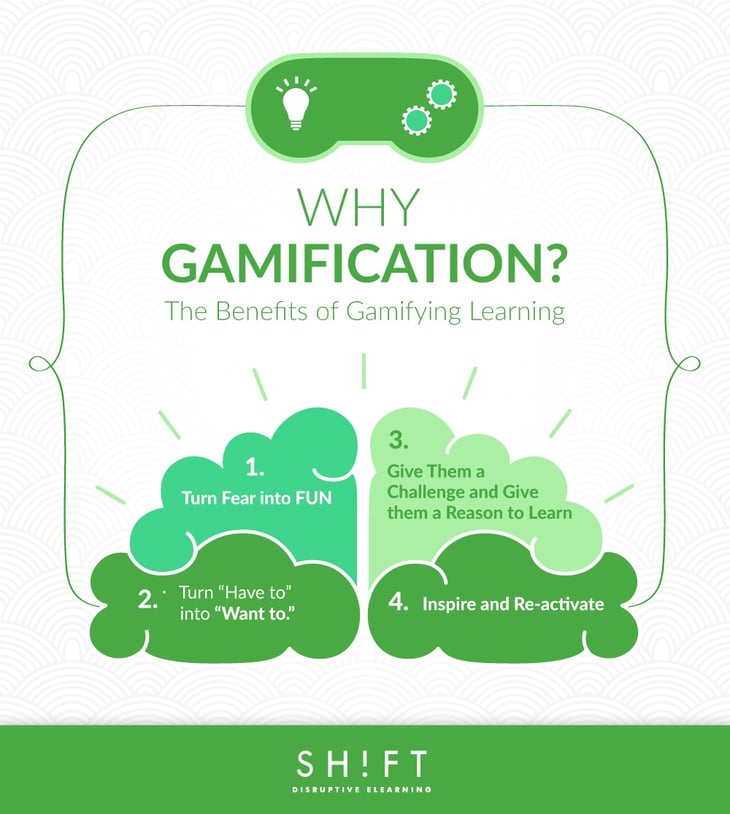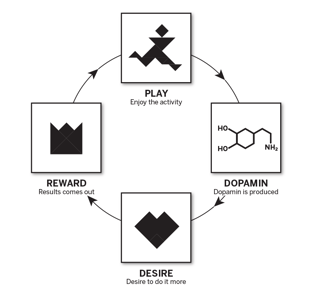It’s time to get serious about playing because when it comes to eLearning, gamification isn't just for fun. While it’s commonly assumed that gamifying your eLearning courses is merely a pleasant distraction or attention grabber, it is far more useful tool than people tend to give it credit for.
According to educational video game designer Marc Prensky “students now learn differently than students did even a generation ago” and "you can't hold people's attention the way you used to.” And because of this attention problem, games are becoming more important than ever in making effective eLearning courses for the actual and coming generations.
As gamification makes seemingly mundane tasks fun, using it appropriately can boost participation rates in eLearning courses, increase employee motivation and even improve retention. In this post we will take an in-depth look at why gamification can make your eLearning courses more engaging and effective.

1) Gamification Turns Fear into Fun
Work is pretty much the antonym of fun as far as most people are concerned, and work-related training is no exception to this. There is a natural element of fear associated with training and a sense that it is something that is merely supposed to be suffered through. Not only does this make for a gloomy experience, but it is also counterproductive since most people can’t retain information very well when taught this way.
Gamification is a way to change that and make things not only more fun but also more productive. Gabe Zichermann, the founder of Dopamine Inc, referenced a study that showed that finding a way to make work fun would increase employees’ ability to retain skills by 40%. This not only helps the employees but the company as a whole since workers will perform at higher levels.
Zicherman, who is also a co-author of "Gamification by Design," went on to say in an interview for Information Week that "If you can make something more fun, and include notions of play, you can get people to do things they otherwise might not want to do." The increased willingness to participate and engage is supported biologically by dopamine, which is released when a person experiences pleasure and increases motivation to continue doing the thing that gave pleasure. This is how gaming rewards work.
Read more in this article: 'Gamification' Techniques Increase Your Employees' Ability To Learn By 40%
2) It Turns "Have to" Into "Want to"
Traditionally, anything that would be considered more like playtime has been looked down upon in the business and training world. However, playing does more than just make things more pleasant. It also encourages people to want to learn more, increase concentration, and increase effort and determination to learn.
This is supported by the work of Dr. Judy Willis, who is a certified neurologist and extensive researcher of how learning occurs in the brain on a chemical level. Her studies have shown that dopamine, that pleasure-giving chemical, is released when people perform tasks that they are uncertain of the outcome or when people enjoy certain activities. Games fit this bill; they are highly unpredictable, they inspire, and the dopamine they release encourages learners to continue. Possibly even more importantly, lessons that are gamified increase retention because learners feel more of a connection with the material.
"If you have ever played any kind of game where there are multiple levels with achievements to unlock then you know how persuasive that setup can be in making you want to try harder". [1]
 Image source: Serious Gaming
Image source: Serious Gaming
3) Give Them a Challenge and Give them a Reason to Learn
There are few things harder than trying to apply the knowledge you gained by passively sitting through it. Gamification’s largest benefit is that it minimizes this very traditional, outdated style of learning by challenging the participant at exactly the right level. When learners feel challenged, they are motivated to keep going and come back for more. People are naturally wired to enjoy the whole process of conquering obstacles and winning to move up to the next level.
Designing eLearning around doable challenges will make the course feel more like a game and less like a lecture. Challenges can take many forms; it could be unlocking sections in a course, it could be a mystery that has to be solved or a compelling narrative with an adversary that is an obstacle to the learner's triumph. What's important is that it encourages an adrenaline spike that comes with trying to be a better, faster learner. Every time a learner feels challenged, and they accomplish a goal; the brain releases dopamine.
Follow this simple 3-step model proposed by the Octalysis Group for integrating challenge into your eLearning courses:
- Build Tension: Create real life scenarios that challenge the learner. A strong story where the player is a kind of protagonist or hero is the first element you need to get learners to engage and care. This creates stress and tension that propels you forward.
- Build Urgency: By having a threat working against the learner you are increasing the need desire to move faster and do better. The key is having the threat be immediate and real. Consider how much more you are motivated to seek medical attention for a broken bone versus how likely you are to try and prevent an illness you don’t have.
- Create time-constraints: A way to build tension, urgency and get all those fun brain chemicals to release is to set a timer on a learning activity. Don’t give learners an easy way out.
Gamers are willing to work, as long as this work challenges them in some way, because, “in a game, players will endure frustration and challenges that in other situations would cause them to give up” (Ladley, 2011, p. 3).
Read: Use of Challenge in Gamification and Learning Design
4) Gamification Inspires, Motivates and Re-activates
We have a natural desire to be curious, discover and to learn, but this is often discouraged with old training methods. Gamification can spark this desire to learn back to life.
Gamifying learning, above most things, provides a focus once attention is captured and inspired. It acts on multiple senses for an immersive experience that increases our enjoyment and desire to achieve goals. This response to purely recreational games is now being harnessed and used in the business world. Consider how beneficial it would be if a salesperson is focused on winning customer as they might be in passing to the next level on a video game.
Ultimately, gamification gives us goals and goals give purpose. When used properly, it uses our natural tendency to be goal-orientated and to set standards we want to achieve in the future. Gamification goes beyond physical rewards and promotes a mindset of constant achievement. Having learners set their own goals for the course and then measuring their progress toward the goal is a way for you to motivate employees when taking an eLearning course and ensure they are committed. There are certain situations when this might not be what you want to engage in your learner but more often than not gamification works where other training methods fail horribly.
Read: Goal Orientation in Gamification by Karl Kapp
Now that you know the reasons why you should use Gamification in eLearning, it's time to analyze if you should. Gamifying just for the sake of making the course more engaging and fun is never a good idea. Gamification should be applied only when it will significantly create a positive change to meet the needs of your audience. Read this article for further detail.
Grab this Free Gamification Template: Gamification Strategy Design Process by Monica Cornetti
REFERENCES:
1. Prensky, Mark. Digital Game-Based Learning Chapter 5. (McGraw-Hill, 2001). http://www.marcprensky.com/writing/Prensky%20-%20Digital%20Game-Based%20Learning-Ch5.pdf
2. Osheim, Darcy E. “THIS COULD BE A GAME!”: DEFINING GAMIFICATION FOR THE CLASSROOM. Darcy E. May 2013



